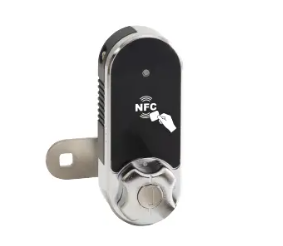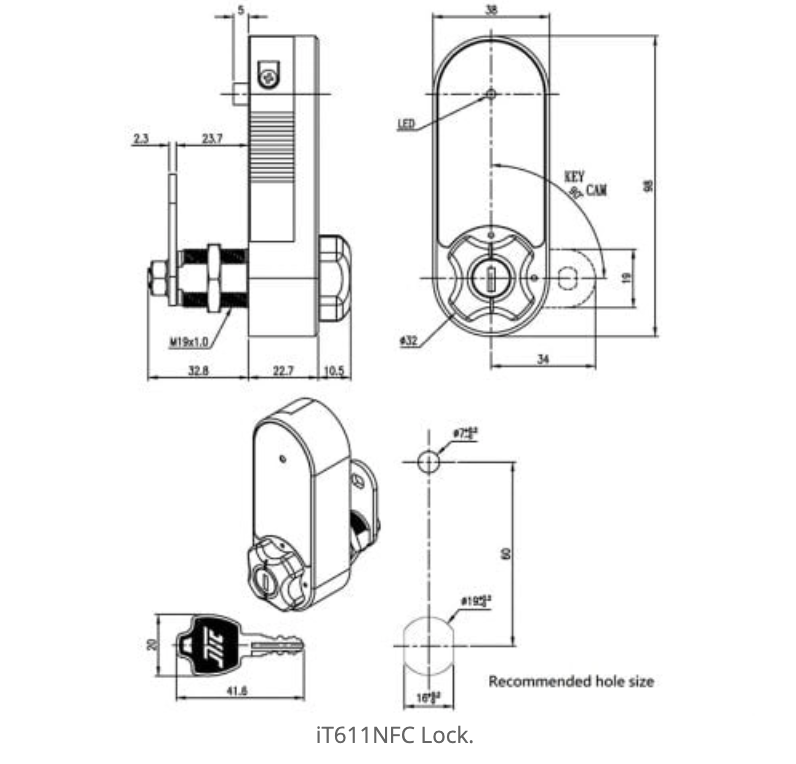Views: 0 Author: Site Editor Publish Time: 2025-09-19 Origin: Site









In today’s fast-evolving world, security is more important than ever, and traditional mechanical locks are being replaced by modern, innovative solutions. A smart cabinet lock is a device that combines technology and security to offer better protection, convenience, and control. Smart cabinet locks are not only more secure but also more convenient, providing features like keyless entry and remote access. They are particularly beneficial for shared offices, medical cabinets, and secure rooms, where access control and tracking are essential.
This article explores the technology, features, types, and benefits of smart cabinet locks, as well as their comparison with traditional mechanical locks.

Smart cabinet locks come with a variety of features that set them apart from traditional locking systems. They provide not just security but also management and sharing capabilities, making them ideal for environments where multiple users need access at different times.
Fingerprint Recognition: One of the most popular authentication methods of smart locks is the biometric fingerprint recognition system. This method ensures that only authorized users can access the cabinet, as each fingerprint is unique. The lock grants access within seconds, offering both security and convenience.
Bluetooth Technology: Many smart cabinet locks rely on Bluetooth to provide keyless entry. With Bluetooth-enabled locks, you can open a cabinet from a distance using your smartphone, eliminating the need for physical keys. This feature is particularly useful in shared office spaces or environments where multiple people need access to the same cabinet.
NFC (Near Field Communication): Some smart locks use NFC technology to unlock cabinets with a simple tap of an NFC-enabled card or smartphone. This feature is particularly popular for high-traffic areas, such as shared storage spaces or computer rooms, where employees need quick, contactless access.
Remote Access Control: Many smart cabinet locks allow administrators to control access remotely through a smartphone app or online portal. This feature is especially helpful in shared workspaces or areas where access needs to be granted or revoked in real-time.
Audit Trails and Activity Logs: One of the key advantages of smart cabinet locks is the ability to keep detailed activity logs or audit trails. Administrators can see who accessed the cabinet, when, and for how long. This is especially useful in environments that require strict compliance, such as medical cabinets, financial institutions, or IT equipment storage areas.
Battery-powered with Backup Options: Most smart cabinet locks run on batteries, making them easy to install without requiring electrical wiring. Some models offer backup options, such as a manual key or a battery backup, in case the lock’s battery dies.
Smart cabinet locks are ideal for a variety of applications, offering more than just physical security. They also improve access management and monitoring.
Shared Offices: In a shared office environment, smart cabinet locks can be used to manage access to office storage, filing cabinets, or locker rooms. This ensures only authorized personnel can access sensitive documents or personal belongings. Administrators can easily track who is using which cabinet and when.
Medicine Cabinets: Smart locks are increasingly being used for medicine storage in hospitals, pharmacies, and clinics. With remote access control, medical professionals can easily access controlled substances while ensuring compliance with safety regulations by tracking who accesses the cabinets and when.
Computer Rooms and Data Centers: In areas where sensitive information or equipment is stored, such as server rooms or data centers, smart locks provide an added layer of security by restricting access to authorized personnel only. These locks can also monitor access and generate logs of who entered and when.
A smart cabinet lock functions using wireless communication and digital encryption. Instead of using a physical key, a smart lock uses a variety of technologies to control access. Here's how smart locks typically operate:

Smart cabinet locks use various authentication methods to grant access, including fingerprint scanning, Bluetooth pairing, or NFC technology. These methods ensure that only authorized individuals can unlock the cabinet.
Fingerprint Scanning: Users scan their fingerprint, which is then compared to the stored data to verify identity.
Bluetooth: Users unlock the cabinet through an app on their smartphone or tablet, which connects to the lock via Bluetooth.
NFC: Users tap an NFC-enabled card or smartphone on the lock to gain access.
Once the user is authenticated, the smart lock receives the signal and either unlocks or locks the cabinet. Bluetooth, NFC, or another wireless protocol transmits this signal from the user’s device to the lock.
When the signal is received, the lock’s internal mechanism, typically a motorized latch or electronic bolt, is activated. This allows the cabinet to be unlocked for authorized users. In some cases, the lock may automatically lock again after a set time for added security.
Smart locks often generate audit trails that record who accessed the cabinet and when. These logs are accessible through a mobile app or online platform, providing a convenient way for administrators to monitor and track access history.
Yes, there are different types of smart cabinet locks, each with unique features and authentication methods. These locks are designed to meet the varying needs of different applications, from high-security environments to low-maintenance settings.
Fingerprint-based locks use biometric recognition to verify the identity of the user. They are highly secure and suitable for high-traffic environments where fast access is needed. They are commonly used in high-security areas or for medicine storage where only authorized individuals should have access.
Bluetooth-enabled locks are controlled via an app installed on a smartphone or tablet. These locks offer remote access within a specific range, usually up to 100 feet. Bluetooth locks are ideal for environments like shared offices or storage rooms where multiple users need access. Bluetooth-enabled locks offer the convenience of keyless entry and remote access.
NFC-based locks allow users to unlock cabinets with a tap of an NFC-enabled card or smartphone. This technology is popular in high-traffic environments, such as conference rooms, computer labs, or employee lockers, where easy access is required.
Wi-Fi-enabled locks allow for remote access and management via the internet. These locks can be controlled from anywhere, making them ideal for situations where real-time access management is necessary, such as multi-location businesses or secure storage facilities.
Keypad smart locks require users to enter a PIN code to gain access. These locks are often found in shared workspaces or common areas where a simple and secure access method is needed. They provide a straightforward and efficient solution for everyday use.
The fundamental difference between traditional mechanical locks and smart locks lies in their operation and the level of security they offer. Here’s a comparison:
Operation: Requires a physical key to open or close the lock.
Security: Provides security through the physical mechanism of the lock, which can be bypassed by lockpicking or key duplication.
Maintenance: Requires minimal maintenance other than occasional lubrication.
Control: Limited to the person with the physical key.
Operation: Uses wireless communication (Bluetooth, NFC, Wi-Fi) and digital encryption to unlock or lock the cabinet, often with keyless entry.
Security: Offers enhanced security with biometric authentication, encrypted access, and activity logs. It is much harder to bypass compared to traditional locks.
Maintenance: Requires regular checks on the battery and occasional updates. Some models may require cleaning or software updates.
Control: Provides greater control over access, including the ability to remotely manage access and track activity via apps or web interfaces.
Smart locks provide a higher level of security than traditional locks, with features such as biometric authentication, encryption, and activity logs that make unauthorized access difficult.
With keyless entry, smart locks make it easier for users to gain access without the need for a physical key. They also allow for remote control, enabling administrators to manage access from anywhere.
Smart locks keep detailed logs of who accessed the cabinet and when. This is valuable for ensuring compliance in environments like healthcare, where tracking access to medication cabinets is critical.
Unlike mechanical locks, smart locks are designed to be more durable and often require minimal maintenance. Most smart locks have long-lasting batteries and are built to withstand wear and tear, making them a low-maintenance option for long-term use.
When selecting a smart cabinet lock, consider the following factors:
1. Authentication Method: Choose a lock that offers the most convenient and secure form of access—whether that’s fingerprint recognition, Bluetooth, NFC, or PIN codes.
2. Compatibility: Ensure that the smart lock you choose works with your existing smart home system or smartphone.
3. Battery Life: Look for a lock with a long battery life or a backup power option in case the battery runs out.
4. Durability: Choose a lock that’s designed to withstand the conditions of your environment, especially if it’s exposed to temperature fluctuations or moisture.
5. Price: While premium models offer more features, basic models can still provide excellent security at a more affordable price.
What are the disadvantages of a smart lock?
Smart locks require battery power and can be vulnerable to technical failures or hacking if not properly secured. Some models may also have compatibility issues with older devices or systems.
What happens to smart locks when the power goes out?
Most smart locks have a manual override feature, such as a physical key, allowing you to still unlock them in case of a power failure.
Can someone break into a smart lock?
While no lock is entirely immune to attack, smart locks provide much stronger security than traditional mechanical locks, especially with biometric features and encryption.
Do smart locks have a manual override?
Yes, most smart locks come with a manual override option, allowing you to unlock them using a physical key if the electronic components fail.
Can smart locks get wet?
Many smart locks are designed to be water-resistant or weatherproof. However, it’s important to check the product specifications to ensure the lock is suitable for wet environments.
Do smart locks automatically lock?
Some smart locks have an auto-lock feature, which automatically locks the cabinet after a set period. However, not all models have this feature, so check the specifications when purchasing.
Can I still use my key with a smart lock?
Yes, most smart locks come with a traditional key option, allowing you to unlock the cabinet manually if necessary.
Choosing the right smart cabinet lock depends on your specific needs. Whether you require fingerprint recognition, Bluetooth connectivity, or NFC technology, smart locks offer enhanced security and functionality compared to traditional mechanical locks. Consider your specific requirements to choose the best model for your space.
For more information on high-quality smart cabinet locks and other security solutions, visit Jintay. Explore a wide range of smart locks designed to meet your unique needs for home and office security.